For more information:
Note that the latest stuff may not yet be indexed.
The Klezmer Shack directory of articles
The New Latest Hot Stuff, 11 Nov 2001
Hasidic New Wave / From the Belly of Abraham, (2001)
Stacy Phillips / From the inside, (2001)
Doina Klezmer / Sorja Tanz, (2001)
Masha Yacubovich / Back to origin, 2001
Moshe Berlin / in unison (music of Shlomo Carlebach)
Yid Vicious / Forverts!
Pete Rushefsky & Elie Rosenblatt / Tsimbl un Fidl: Klezmer Music for Hammered Dulcimer and Violin
Mark Rubin presents Hill Country Hannukah
The Klezmer Moshe Berlin / Jewish Soul Music
Jon Stein's Musaic / The Yiddish Fantasy
I had such an amazing feeling last spring that I was going to catch up on the wave of excellent klezmer and other music with which the 'Shack gets innundated. Fat chance! But I can at least take some time out to let you know what we're listening to and grooving to here in cyberspace.
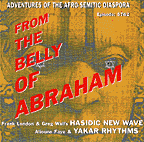 Hasidic New Wave / From the Belly of Abraham (Knitting Factory/JAM KFW 294).
Hasidic New Wave / From the Belly of Abraham (Knitting Factory/JAM KFW 294).
The Klezmatics' Frank London, and sax maven Greg Wall have been exploring avant Jewish waves for several years. This latest CD catches the band in a nicely percussive groove with the Yakar Rhythms group. The addition of this wall o' drums coheres the explorations of what has occasionally been individualistic noodling, nicely. On the one hand, this could be the gang on the beach in Tel Aviv drumming to welcome in the Sabbath. On the other hand, there is such a neat slipping and sliding of influences and rhythms and explorations you'll find yourself periodically stopping just to listen, too. From the opening "Waaw-Waaw," into a truly excellent "Yemin HaShem," through the rhythmic fusion of Jewish and Senegal in "Bo-Peep" and onwards, the album sub-title, "Adventures of the Afro-Semitic Diaspora," is to be taken seriously. The more I do listen, the more I find it harder to put this one away. Maybe I'll just bring it in to work. In addition to London's and Wall's horns and reeds, the bass playing by Fima Ephon is excellent. Majorly excellent. And David Fiuczynski's guitar wails. Still, I wish there were more occasions when I felt that the band was improvising tightly together, even so much as the call/response as on "Frydginator," or the interleaving of the ballad, "The Sacred Line", as opposed to mostly providing a framework for solos. Highly recommended, just not perfect. [GRADE: A-]
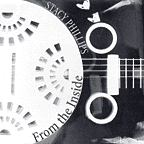 Stacy Phillips / From the Inside (Archduke Combine 02. Contact: Stacy Phillips, 298 Cromwell Hill Rd., Monroe, NY 10950.
Stacy Phillips / From the Inside (Archduke Combine 02. Contact: Stacy Phillips, 298 Cromwell Hill Rd., Monroe, NY 10950.
I will confess a strong predilection towards almost all forms of American folk music. I'll also confess that Stacy Phillips hits almost every high point on this new release, from klezmer to Hawaiian to bluegrass to Western Swing. The album may not have much to do with Klezmer (although there is a most fine klezmer medley) or Jewish music (although there are lovely songs in perfect American folk tradition about both Ruth, and King David's son, Absalom, from a non-Jewish Bible perspective--if you love the thoughtful, harmonizing a capella gospel story songs, these are the perfect examples of the genre at its best).... This album is just damn beautiful, and if I don't write about it hear, you may miss it. That's good enough for a mention here. Phillips has a masterful touch on one of my favorite instruments, the dobro, a steel-bodied guitar that is often associated today with old-timey music from the first half of the last century, or with Hawaiian music (think Gabby Pahinui's slack-keyed guitar). But this album crosses all American genres, including the aforementioned klezmer medley (did I mention that Phillips is also the author of some klezmer fake books?), with distinguished visitors such as Tony Trischka on banjo, and the lovely harmonies we now associate with bluegrass. Listening to this album is like listening to Gabby Pahinui, or Mississippi John Hurt, or your favorite gentle, totally fluid, totally present practitioner of American roots musics. This will make a fine album to go with your new Andy Statman, er, "Wayfaring Stranger" CD. Oh, and there's that klezmer medley :-). [GRADE: A+]
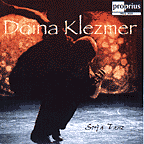 Doina Klezmer / Sorja Tanz (Proprius PRCD 2009. Contact: www.proprius.com).
Doina Klezmer / Sorja Tanz (Proprius PRCD 2009. Contact: www.proprius.com).
I have heard so much decent, but unexciting klezmer from Europe that I had begun to fear that I was being influenced by the source of the recordings, not by their quality. Then along came this delightful recording by a Finnish band, Doina Klezmer, and I did a double take and got excited. This is a most excellent fusion of traditional-sounding klezmer with some wonderful extended improvisation. The band takes the usually blah "Gasn Nign", a song that I loved very much before I heard it for the 50,000th mediocre time, and makes me listen again. Or, for that matter, consider a "Sirba" that owes as much to American bluegrass (or the Romanian equivalent) as to klezmer. Or, consider the intro to the "Freilachs" which sounds, at first, like a jazz tune. Finally, I have to call special attention to tunes penned by group member Sampo Lassila that are wonderful fusions of everything, starting with klezmer and even gypsy music--the sort of fluid improvisational music that makes listening and dance a pleasure (As an odd note, the long bass improv opening "Mehta Shavota" reminded me of the bass lines that open Black Sabbath's "Iron Man." I was worried :-!). The closing, thoughtful, occasionally mournful "Kairan Taksim" is an excellent example of the band's ability to ponder and to fuse many musics into something familiar, yet new. This is the first new modern European klezmer band that has made me really, really pay attention since Italy's Klezroym. (This is not, of course, to ignore bands like Brave Old World, Budowitz, or Di Naye Kapelye which are not new, only of enduring excellence), I don't know if it is true that "Doina Klezmer is not just a klezmer band -- it is a Finnish klezmer band", but it has very much achieved that rare fusion of current world music influences and poured the whole thing into an eclectic, exciting album. [GRADE: A]
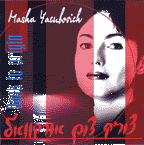 Masha Yacubovich / Tzurik tzum Urkval (Back to origin) (Arthur I. Chirgadze, carthur@mail.ru or carthur@pisem.net).
Masha Yacubovich / Tzurik tzum Urkval (Back to origin) (Arthur I. Chirgadze, carthur@mail.ru or carthur@pisem.net).
This e-mail arrives one day from Uzbekistan. Who knew there were Yiddish-speaking Jews in Uzbekistan? Who knew that one of them has the voice of a nightingale and can sing Eastern European Jewish standards with a grace that needs minimal accompaniment and pleases so thoroughly? From the opening standard (not by Shlomo Carlebach, but by Baruch Chait of Rabbi's Sons fame, to my surprise), "Mi Ha-ish", this is a captivating vocal album. Forget it's source (except insofar as it complicates getting your own copy). Enjoy an impressive album that includes not only familiar older repertoire, but the aforementioned "Mi Ha-ish", or the very recent "di Krenitse" and "Ikh stey unter a bokserboym" from Chava Alberstein and the Klezmatics. [GRADE: A]
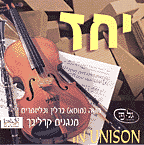 Moshe Berlin / Yakhad (in unison, music of Shlomo Carlebach) (Gal Paz. Contact: www.galpaz.co.il).
Moshe Berlin / Yakhad (in unison, music of Shlomo Carlebach) (Gal Paz. Contact: www.galpaz.co.il).
The musical highlight of my visit last summer to Israel was an afternoon visiting with Moshe Berlin, talking about music and tradition. I'd say that most of my klezmer listening since has consisted of going through the stack of CDs with which we decamped. This CD, although not my personal favorite, is a wonderful introduction to the joy and fluidity of Berlin's playing, in the context of the late Reb Carlebach's well-known melodies. Attention has also been paid to the order and continuity of the melodies, so that they comprise a meaningful whole. For those unfamiliar with his work, this is also an excellent introduction to Berlin's ability to take traditions, even recent traditions, and to transform them into mizmorim, songs of the moment, demonstrating perfect continuity and a perfect sense of the present here and now. Witness, for instance, the haunting intro to "Rakhem b'chasdekha" transformed to such immense joy. Berlin's Carlebach recordings are also available in the US from Tara Music, www.tara.com. (Historic note: bassplayer Eli Magen was also a vocalist and bass player for the first great Israeli rock band, Apocalypse around 1970. Listen to his desperate vocals then on "Open for me the door" and the joy of his playing here! Different gigs, different times ;-).) [GRADE: A]
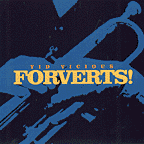 Yid Vicious / Forverts, 2001 (Uvulittle Records, www.uvulittle.com).
Yid Vicious / Forverts, 2001 (Uvulittle Records, www.uvulittle.com).
Back in 1998, a cassette recording of Yid Vicious' first album helped me survive what I hope will be my last drive cross country (and if not the last drive, the last steering a large truck). The band may have been imperfect, but the name was great, the the album cover and album name were my favorites of the year. And the music provided ongoing aural relief from Patsy Cline and Hank Williams. Fast forward to this new recording, and the band is better, much better ... brassy and excited about the music, but playing it with a better feel. This is an infectious blend of American swing and early American recorded klezmer. The new vocalist, Anna Purnell, from the much acclaimed Balkan fusion world music hodge podge, Reptile Palace Orchestra (I like Yid Vicious better, but maybe the Reptiles are better since I was last in Madison, too!) is great. Her sense of Yiddish and swing remind me of the Austin singer, Rachel Rhodes (see Austin Klezmorim and Rubinchik's Orkestyr). This is very good. Her version of "Lomir Zich Iberbetn", this year's "everybody's doing it" recording, is worth hearing! Lest one think this is entirely in the spirit of the early klezmer revival, there is a version of "A Gleyzele Vayn" that reminds me of the heavy metal klezmer meanderings of Cayuga Klezmer. But that's followed by the title track, "Forverts!" very much in the spirit of exactly that early klezmer revival at its best. In this regard, the band follows also in the same tradition as that of New York's acclaimed Metropolitan Klezmer, whose "Bulgar in C Minor" is here recorded as "Metropolitan Bulgar. The ska-influenced "Kammen Islands Medley" helps round the album out wonderfully, too. All-in-all, an unexpected pleasure and a most excellent album. [GRADE: A]
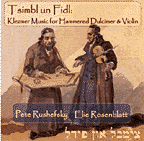 Pete Rushefsky & Elie Rosenblatt / Tsimbl un Fidl: Klezmer Music for Hammered Dulcimer and Violin, 2001 (Contact: Pete Rushefsky and Elie Rosenblatt).
Pete Rushefsky & Elie Rosenblatt / Tsimbl un Fidl: Klezmer Music for Hammered Dulcimer and Violin, 2001 (Contact: Pete Rushefsky and Elie Rosenblatt).
Unless you have heard the Joseph Moscowitz "Art of the Cymbalom" album, or paid close attention to the amazing releases by Budowitz and Khevrisa, this album may be covering new, and wondrous ground for you. If you have heard those albums, you no doubt ran out, purchased this CD as soon as it was announced, and are happily enjoying it even as I type. There is something about the tsimbl, and even better, a tsimble and fiddle that is the klezmer equivalent of comfort food, especially when they are played this well. For newcomers, it is worth noting that the tsimbl was the major (a major?) klezmer instrument until relatively modern times, gradually supplanted by the violin, and then, only in the last hundred or so years, by clarinet and trumpet. Rushefsky and Rosenblatt have recorded a marvellous recital of the music of that earlier period. Although neither player is driven the way an Alicia Svigals and Josh Horowitz might be, there are sparks of fire on this album that ensure much interest. Still, overall, the album is more like a recital than a party piece. I like listening to it, but I never get up and dance. I'm not sure that is a complaint, though. As an introduction to the art of tsimbl and violin duos, much of which has yet to be transcribed, this is a welcome and lovely recording of a repertoire that is new to most klezmer fans. Enjoy! [GRADE: A-]
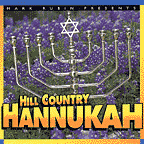 Mark Rubin presents / Hill Country Hannukah, 2001 (Contact Rubinchik Recordings, POB 49227, Austin, TX 78765, www.markrubin.com/rubinchik).
Mark Rubin presents / Hill Country Hannukah, 2001 (Contact Rubinchik Recordings, POB 49227, Austin, TX 78765, www.markrubin.com/rubinchik).
I have enjoyed a wide variety of recordings by Mark Rubin over the years, and that may have set me up to expect more from this recording, from a Hannukah-time radio broadcast last year. The band is good and starts the CD off with some delightful klezmer. The main problem, however, is that I find it hard to get excited about most of the vocals. Cantor Neil Blumofe sounds entirely out of range on a Western Swingish version of "Maoz Tzur". The arrangement is what one would expect from Austin, TX. But the execution is a little too ad hoc, and the vocals, too noticably not there. (Cantor Blumofe is better on the "Heimisher Bulgar", but even here, there are some notable lapses off key.) I like the addition of the entire Cong. Agudas Achim choir, but here, too, I'm not convinced that the choir wasn't sight reading. As much as I wish things sounded more practiced, the repertoire is really well-chosen, including not only familiar Ashkenazic fare, but a well-intentioned "Shalom Alenu" and a lovely "Ocho Candelikas", as well a notable "Haneirot Halalu" sung by Galeet Dardashti in Mizrahi style accompanied only by hand drum. The album closes in fine style with further freilachs and Rubin's excellent Yiddish Ensemble. [GRADE: B]
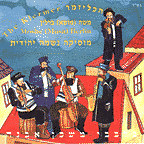 The Klezmer, Moshe Berlin, ? (Gal Star, Israel, +03 676 0487).
The Klezmer, Moshe Berlin, ? (Gal Star, Israel, +03 676 0487).
 Here's an example of the straight-ahead klezmer style of Moshe Berlin. Although I find some of the arrangements limiting, the clarinet playing is superb, and this is such a wonderful example of many of the traditional Jewish wedding tunes, as passed down through the Meron tradition to Berlin. Listen to his version of "Ish Khasid Haya" and try not to weep. When we talked about his music this past summer, Berlin compared his work to that of musicologist Zev Feldman (also of Khevrisa). Feldman, he noted, looked at Jewish traditional wedding music and tried to extrapolate backwards to earlier music. He, Berlin, started with the same traditions and had done his best to stick to the intention of the tradition while keeping it alive and sounding right for this time and place. It is a nice way to describe both the soul ("Jewish Soul Music" is the subtitle of this CD) of this music, and Berlin's mastery of the genre. This becomes especially evident on pieces such as the Meron "Arabesque" or Reb Michel Zitshiver's Nigun. Then there will be pieces such as "Dynasty Vol. 2" that exemplify a "bar mitzvah beat"-bounded melody that may fit a wedding perfectly, but here, between the flute and the drum kit, seems to lose clarity. (This is not to claim that this tune loses its beat, or the compulsive dance imperative, therein.) Klezmer in the United States has gone through several generations of changes--it was infused with jazz and much else in the first half of the 20th century. The revival of the last 25 years has added all sorts of new influences. In contrast, Berlin is playing a tradition that was handed down for generations and remains internal to a Jewish religious community, now in Israel. This is not just a primary source of klezmer tradition, this is an amazingly soulful example of that source. [GRADE: A]
Here's an example of the straight-ahead klezmer style of Moshe Berlin. Although I find some of the arrangements limiting, the clarinet playing is superb, and this is such a wonderful example of many of the traditional Jewish wedding tunes, as passed down through the Meron tradition to Berlin. Listen to his version of "Ish Khasid Haya" and try not to weep. When we talked about his music this past summer, Berlin compared his work to that of musicologist Zev Feldman (also of Khevrisa). Feldman, he noted, looked at Jewish traditional wedding music and tried to extrapolate backwards to earlier music. He, Berlin, started with the same traditions and had done his best to stick to the intention of the tradition while keeping it alive and sounding right for this time and place. It is a nice way to describe both the soul ("Jewish Soul Music" is the subtitle of this CD) of this music, and Berlin's mastery of the genre. This becomes especially evident on pieces such as the Meron "Arabesque" or Reb Michel Zitshiver's Nigun. Then there will be pieces such as "Dynasty Vol. 2" that exemplify a "bar mitzvah beat"-bounded melody that may fit a wedding perfectly, but here, between the flute and the drum kit, seems to lose clarity. (This is not to claim that this tune loses its beat, or the compulsive dance imperative, therein.) Klezmer in the United States has gone through several generations of changes--it was infused with jazz and much else in the first half of the 20th century. The revival of the last 25 years has added all sorts of new influences. In contrast, Berlin is playing a tradition that was handed down for generations and remains internal to a Jewish religious community, now in Israel. This is not just a primary source of klezmer tradition, this is an amazingly soulful example of that source. [GRADE: A]
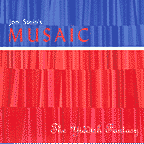 Jon Stein's Musaic / The Yiddish Fantasy, 2001 (Kosher Jazz CD 01, www.musaic.org.uk).
Jon Stein's Musaic / The Yiddish Fantasy, 2001 (Kosher Jazz CD 01, www.musaic.org.uk).
This lovely Jewish-tinged generic jazz album was described to me as "klezmer meets Afro Blue". That may be taking things a bit too far--there is none of the drive or innovation or edges here that would invite comparison to Coltrane. Only the ensemble is similar: sax, piano, bass, drums (here there is also a trumpeteer). But neither is this anything less than inviting, accessible, and professionally played. If I have a complaint it is that the music does not transcend. It is comfortable jazz, well-played, without edges. There are no surprises here, and I like to be surprised. The music is sufficiently generic that the wealth of Ladino culture can be represented by a piece inflected with salsa, but reminiscent of no particular Judeo-Spanish melody. (I am sometimes surprised by how many of my friends and acquaintances find music composed this well, played this well, to be preferable to my beloved edges and surprises.) If you enjoy Jewish-tinged jazz ensembles such as Kol Simcha, this recording will be of considerable interest. [GRADE: B]

